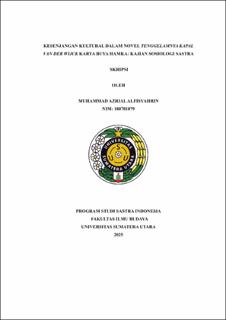| dc.description.abstract | This study aims to analyse the representation of cultural disparity in the novel
Tenggelamnya Kapal Van der Wijck by Buya Hamka using a literary sociology
approach. The novel was selected because it explicitly reflects cultural conflicts
within Minangkabau society, particularly toward characters of mixed descent who
face social rejection due to their lack of formal recognition under traditional
customs. This phenomenon illustrates a socially discriminatory reality embedded
within local cultural constructs that remain prevalent to this day.
This research employs a descriptive qualitative approach with textual analysis as
the primary method. The primary data is drawn from the content of the novel, while
secondary data is obtained from books, scholarly journals, and relevant articles.
The analysis utilises Alan Swingewood’s theory of literary sociology, Antonio
Gramsci’s theory of hegemony, and George Herbert Mead’s theory of symbolic
interactionism to strengthen the reading of the social realities portrayed in the
literary work.
The findings indicate that the novel represents complex forms of cultural disparity,
including discrimination against dual identities, the hegemony of customs in the
Minangkabau matrilineal system, and resistance to traditional values by modernist
characters. The character Zainuddin is portrayed as a symbol of marginalised
groups unacknowledged by certain social structures due to lineage, reflecting an
exclusive social system that restricts space for difference.
The study concludes that Buya Hamka’s novel contains not only aesthetic value but
also a powerful social critique against discriminatory cultural practices. Thus, the
work is relevant as a medium for reflection and education in modern multicultural
societies in recognising the importance of tolerance, inclusivity, and appreciation
of cultural diversity. | en_US |


